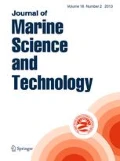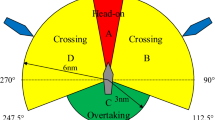Abstract
Efficient maritime navigation through obstructions at close range is still one of the many problems faced by mariners. The increasing traffic densities and average cruise speed of ships also impede the collision avoidance process by reducing the time available for decision making. This study develops a path-planning algorithm that determines an optimal navigation path for ships in close-range encounters, using known and predicted data about the traffic and environment. An improved ship dynamic model has also been developed to better approximate the ship movement under external influences, and the algorithm was evaluated with a set of test cases simulating various traffic scenarios typically encountered at close range. Since the method is based on evolutionary algorithm, the algorithm behaviours were evaluated statistically, where properties such as consistency and practicality of the algorithm outputs are discussed.















Similar content being viewed by others
Notes
In this article, a ship that is in direct control is referred as own ship (OS); any other ship besides OS is referred to as target ship (TS) or obstacle.
References
Eiben AE, Smith JE (2003) Introduction to evolutionary computing. Natural Computing Series, Springer, Berlin Heidelberg
Sait SM, Youssef H (2000) Iterative computer algorithms with applications in engineering: solving combinatorial optimization problems. Wiley-IEEE Computer Society Press, Los Alimos
Statheros T, Howells G, McDonald-Maier K (2008) Autonomous ship collision avoidance navigation concepts, technologies and techniques. J Navig 61:129–142
Tam CK, Bucknall R (2009) Collision risk assessment for ships. J Mar Sci Technol. doi:10.1007/s00773-010-0089-7
Tam CK, Bucknall R, Greig A (2009) Review of collision avoidance and path planning methods for ships in close range encounters. J Navig 62(3):455–476
Acknowledgments
The authors express their gratitude for the financial support by the Atlantic Centre for the Innovative Design and Control of Small Ships (ACCeSS), which is is an ONR-NNRNE programme with grant number N0014-03-0160. The group consists of universities and industry partners conducting small-ship-related research.
Author information
Authors and Affiliations
Corresponding author
About this article
Cite this article
Tam, C., Bucknall, R. Path-planning algorithm for ships in close-range encounters. J Mar Sci Technol 15, 395–407 (2010). https://doi.org/10.1007/s00773-010-0094-x
Received:
Accepted:
Published:
Issue Date:
DOI: https://doi.org/10.1007/s00773-010-0094-x




